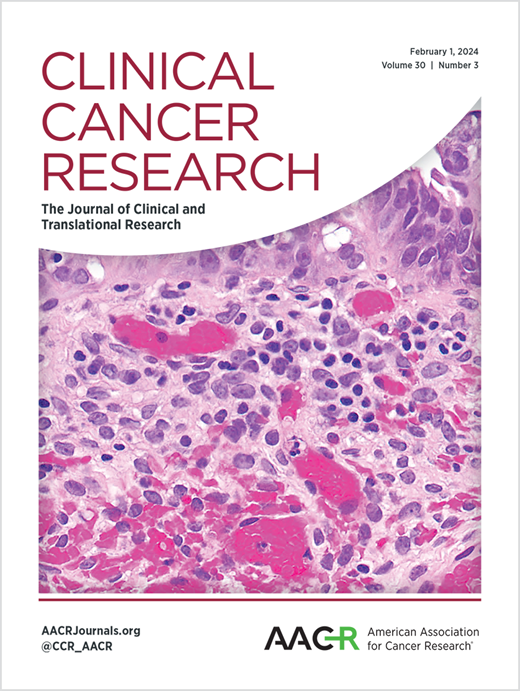CINSARC AND SARCULATOR IN PATIENTS WITH PRIMARY RETROPERITONEAL SARCOMA: A COMBINED ANALYSIS OF SINGLE INSTITUTION DATA AND EORTC-STBSG-62092 TRIAL (STRASS).
IF 10.2
1区 医学
Q1 ONCOLOGY
引用次数: 0
Abstract
PURPOSE The Complexity Index in SARComas (CINSARC) predicts the metastatic risk in patients with soft tissue sarcoma. The aims of this study were to provide the first independent validation of CINSARC in patients with retroperitoneal sarcoma (RPS) and to evaluate whether CINSARC could enhance the performance of Sarculator. EXPERIMENTAL DESIGN A retrospective cohort included patients with primary localized RPS resected with curative intent (2011-2015) at a single institution. The STRASS cohort comprised patients from the surgery-only arm of the EORTC-STBSG-62092 (STRASS) trial who had undergone CINSARC categorization. Patients were classified as CINSARC low-risk (C1) vs high-risk (C2). Primary study endpoints were overall survival (OS) and disease-free survival (DFS). Sarculator performance was assessed in terms of discrimination (Harrell's C-index) and calibration (calibration plots, Brier score) before and after adding CINSARC. RESULTS The study cohorts included 104 and 69 patients, respectively, with similar OS. In a pooled cohort, at multivariable analysis for OS considering Sarculator and CINSARC, only Sarculator was significantly associated with OS (HR 1.93, 95%CI 1.35, 2.74, p<0.001). In multivariable analysis for DFS, both Sarculator (HR 1.51, 95%CI 1.09, 2.09, p=0.013) and CINSARC (HR 2.01, 95%CI 1.26, 3.23, p=0.004) were significantly associated with DFS. However, the addition of CINSARC did not improve Sarculator's discrimination or calibration for either OS or DFS. CONCLUSION This study validates CINSARC as a prognostic predictor for OS and DFS in patients with primary RPS. CINSARC did not improve the performance of Sarculator, suggesting that its addition to the Sarculator may not provide added clinical benefit.原发性腹膜后肉瘤患者的Cinsarc和sarator:单一机构数据和eortc-stbsg-62092试验(strass)的联合分析
目的用sarcoma复杂性指数(CINSARC)预测软组织肉瘤患者的转移风险。本研究的目的是提供CINSARC在腹膜后肉瘤(RPS)患者中的首次独立验证,并评估CINSARC是否可以提高Sarculator的性能。实验设计:回顾性队列研究包括在单一机构(2011-2015)因治疗目的切除原发性局限性RPS的患者。STRASS队列包括EORTC-STBSG-62092 (STRASS)试验中接受CINSARC分类的仅手术组患者。将患者分为CINSARC低危(C1)和高危(C2)。主要研究终点是总生存期(OS)和无病生存期(DFS)。通过添加CINSARC前后的鉴别(Harrell’s C-index)和校准(校准图、Brier评分)来评估分级器的性能。结果研究队列分别包括104例和69例具有相似OS的患者。在合并队列中,在考虑Sarculator和CINSARC的OS多变量分析中,只有Sarculator与OS显著相关(HR 1.93, 95%CI 1.35, 2.74, p<0.001)。在DFS的多变量分析中,sarator (HR 1.51, 95%CI 1.09, 2.09, p=0.013)和CINSARC (HR 2.01, 95%CI 1.26, 3.23, p=0.004)与DFS显著相关。然而,CINSARC的加入并没有改善sarator对OS或DFS的辨别或校准。结论:本研究验证了CINSARC作为原发性RPS患者OS和DFS的预后预测因子。CINSARC并没有改善Sarculator的性能,提示其加入Sarculator可能不会提供额外的临床益处。
本文章由计算机程序翻译,如有差异,请以英文原文为准。
求助全文
约1分钟内获得全文
求助全文
来源期刊

Clinical Cancer Research
医学-肿瘤学
CiteScore
20.10
自引率
1.70%
发文量
1207
审稿时长
2.1 months
期刊介绍:
Clinical Cancer Research is a journal focusing on groundbreaking research in cancer, specifically in the areas where the laboratory and the clinic intersect. Our primary interest lies in clinical trials that investigate novel treatments, accompanied by research on pharmacology, molecular alterations, and biomarkers that can predict response or resistance to these treatments. Furthermore, we prioritize laboratory and animal studies that explore new drugs and targeted agents with the potential to advance to clinical trials. We also encourage research on targetable mechanisms of cancer development, progression, and metastasis.
 求助内容:
求助内容: 应助结果提醒方式:
应助结果提醒方式:


